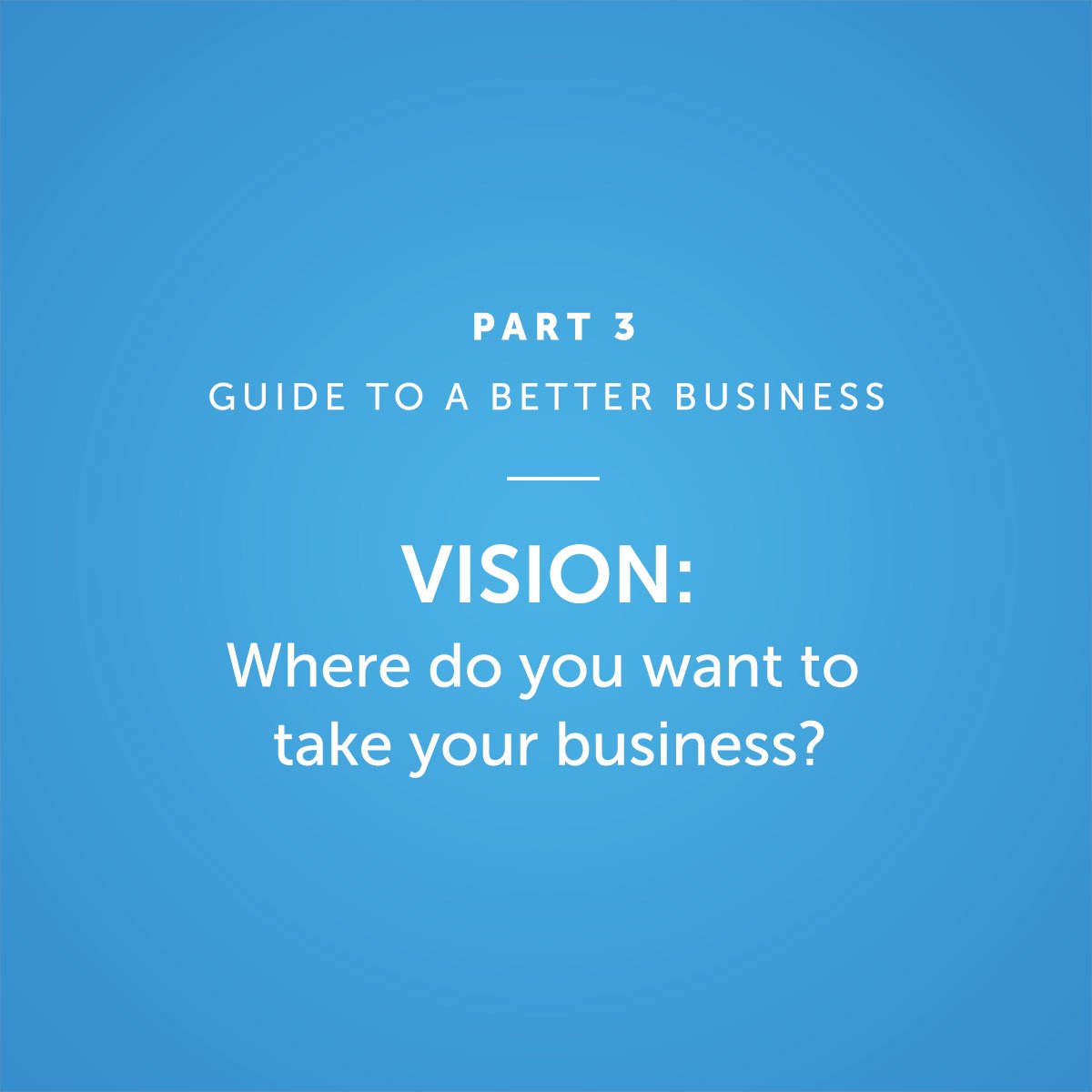PART 3 – GUIDE TO A BETTER BUSINESS
VISION:
Where do you want to take your business?
Where do you want to take your business?
C
T
I
O
N
Success, Pupose, Freedom, Fulfilment, Peace
When you first had the thought to start your own business, what inspiring images came to mind?
No doubt, you had some pretty powerful ideas about where you thought your business would go? What it would achieve? Where it would end up?
Perhaps you pictured a high-performing office environment with dozens of employees? Or an award-winning business in your chosen field?
Maybe you even imagined future Christmas parties and the camaraderie between your team or the pride on the faces of your own family when they explain to others about the successful business you’ve grown?
The point is that this vision is powerful. It’s visually and emotionally engaging. You didn’t just imagine numbers on a profit and loss statement, or supplier contracts or office stationary. You thought of all the exciting and positive things that you and everyone else in your organisation would be part of.
It must be powerful as it caused you to give up the security of employment and set off on your own.
Now we need to harness that strength and use it to ensure that your goal-setting and strategizing are designed to get you to the oasis of success and happiness you imagined.
The importance of your vision
Having already defined your ‘Why’, documenting where you want to take your business helps build your overall vision.
This will:
- Motivate you and your team to continue to improve.
- Help to keep you all on the ‘straight and narrow’ when faced with conflicting ideas and opportunities in the coming years. If you know where you’re heading, you can minimise distractions and understand when to say ‘no’ to opportunities that are not right and ‘yes’ to the priorities. This is difficult without a clear vision.
- Allow your team to understand where the business is heading without constant reminders and micro-managing. This will raise engagement by connecting them to your business’s goals and aid decision-making throughout the organisation.
- Provide opportunities for team members to grow personally and professionally. Top performers can visualise and improve their own futures in alignment with your business vision. By understanding where they’re heading, traditional walls between employees and business owners are broken down, providing opportunities to contribute and inspiring them to generate ideas.
- Allows you to set short-term goals for you and your team so that you can measure progress towards the long-term vision.

The importance of your vision
Having already defined your ‘Why’, documenting where you want to take your business helps build your overall vision.
This will:
- Motivate you and your team to continue to improve.
- Help to keep you all on the ‘straight and narrow’ when faced with conflicting ideas and opportunities in the coming years. If you know where you’re heading, you can minimise distractions and understand when to say ‘no’ to opportunities that are not right and ‘yes’ to the priorities. This is difficult without a clear vision.
- Allow your team to understand where the business is heading without constant reminders and micro-managing. This will raise engagement by connecting them to your business’s goals and aid decision-making throughout the organisation.
- Provide opportunities for team members to grow personally and professionally. Top performers can visualise and improve their own futures in alignment with your business vision. By understanding where they’re heading, traditional walls between employees and business owners are broken down, providing opportunities to contribute and inspiring them to generate ideas.
- Allows you to set short-term goals for you and your team so that you can measure progress towards the long-term vision.
Keys to developing a great vision
Remember how your imagination pictured much more than a balance sheet when you started out?
So, when writing down your vision, capture all of the details that make it engaging and inspiring:
- Think long-term – at least 10 years ahead. Your vision should represent the business legacy that you’re trying to build. Thinking only one year or two years ahead is shorter- term goal setting rather than long-term thinking.
- Be visual – outline what it will look and feel like to be part of the business. A photo or video from the future just isn’t possible, so this needs to be the next best thing.
- Keep it simple to understand – and easy for people to relate to. Don’t use industry jargon that may lose some of your team members.
- Include a timeline – this ensures that momentum can be created. It’s only a dream otherwise.
- Set some boundaries, if necessary – what types of work are out of the question?
Example of a powerful vision
Here’s an example of what a strong vision might look like for a professional services firm:
- Group revenue to reach $100m in FY2049 (30 years).
- A national presence via a large network of small, highly motivated firms, providing first-rate, personalised service.
- A network of complementary service providers, ensuring our clients have seamless access to the services they require to run better businesses.
- Centralised administration and services, ensuring that the network has the most efficient back-office possible, allowing each business unit to put their full energy and focus into servicing their clients.
- Annual conferences with 500 attendees from around the country.



Leave A Comment